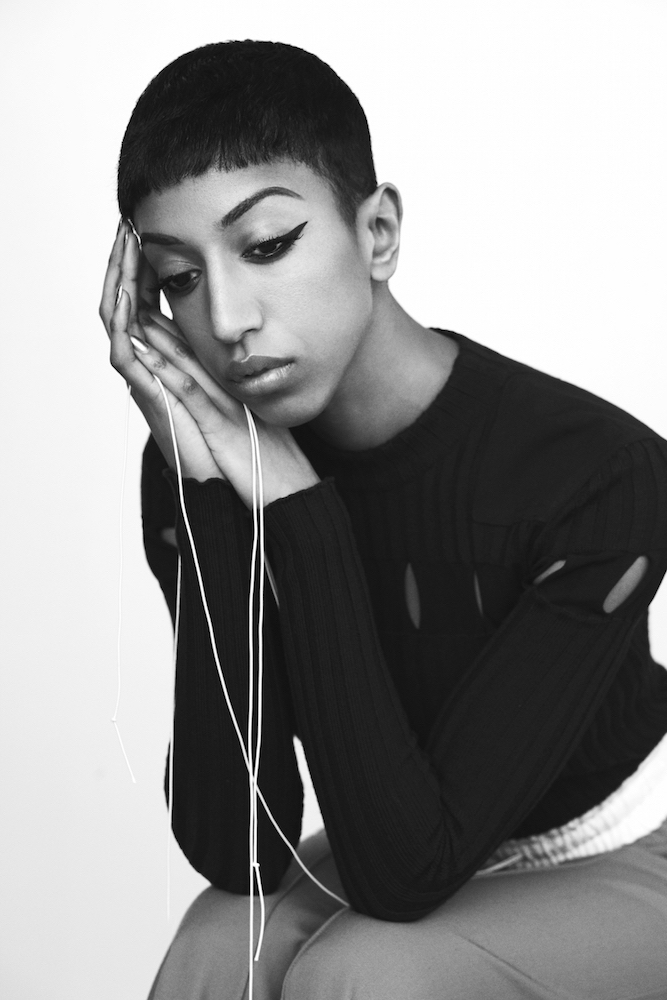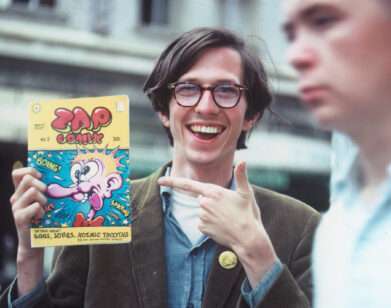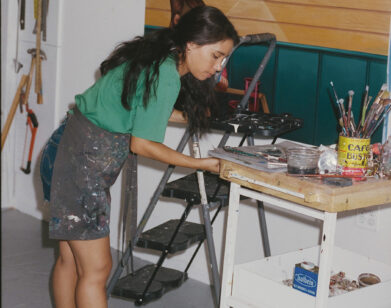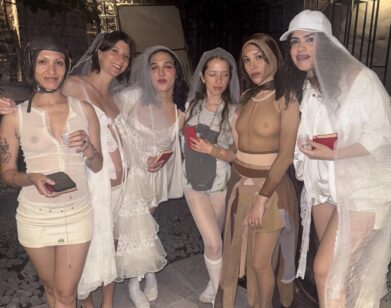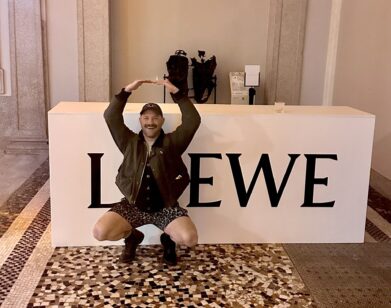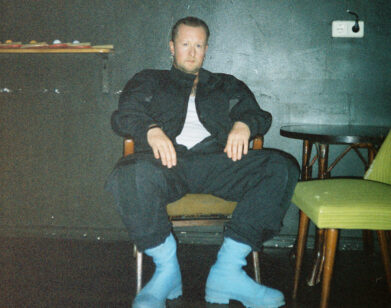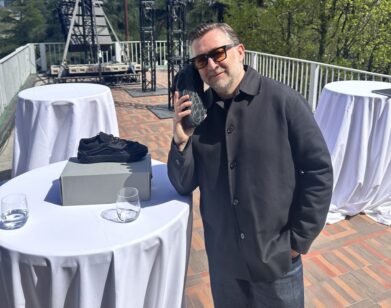Kesh, In the Light
KESH IN NEW YORK, JANUARY 2016. PHOTOS: ELLINOR STIGLE. STYLING: KAROLINA BROCK. MAKEUP: LAURA STIASSNI/ARTLIST. HAIR: LINDA SHALABI/SEE MANAGEMENT. PHOTO ASSISTANT: JETT DROLETTE. STYLING ASSISTANTS: BRIA DAWKINS AND JASMINE HOLZENTHAL. RETOUCHING: MORPH RETOUCH C/O ARCMEDIAPICTURES.COM.
For three months, British artist KESH lived at Catherine Ahnell Gallery in SoHo, developing her solo exhibition “LJUS2.” “That’s how I tend to work,” she says. “I always live and work within the space.” Currently on view, KESH’s digitally manipulated self-portraits hang on the white walls, illuminated only by an animated projection. As the projection moves, shadows shift behind the works, effectively referencing the show’s title, which translates from Swedish to “Light.” For each piece, KESH collages on her computer, beginning with as many as 1,200 images, before reaching a final rendering and printing the artwork. She printed directly on paper for years, but with this show, she printed on large-scale Plexiglas, an experiment that began with smaller pieces during her previous show “Flight:RS279” in L.A. In spite of her large source material, certain elements, such as a graphic black-and-white eye as well as employing numerology in exhibition titles, continually recur throughout her practice.
Keeping artwork accessible is another crucial point for the artist. In 2013, KESH collaborated with American Apparel, launching a line of clothing emblazoned with original artwork from her first solo show in Los Angeles, selling t-shirts for no more than $30. Last year, however, Versace launched a similar design, selling almost exact replicas for $650. “This hurts,” she commented on her Instagram post, “what is this madness?” KESH is now suing the label, and at “LJUS2,” she presents an affordable concept pop-up shop dedicated to the show, so that any visitor, with any budget, can become a collector of her work.
“A lot of people admire and appreciate art, but I know not everyone can afford a $16,000 piece of work,” the 29-year-old continues when we meet her at the gallery. “I mean, almost no one can afford that. I want to make sure I keep things inclusive.”
EMILY MCDERMOTT: You’re from London, but all of your shows have been in America and you always create the works within the space you live. Have you always lived in a gallery setting or is more like you live in a temporary studio and the artworks are then moved to a gallery?
KESH: For the first show I lived in the gallery. I created my own space, which was called the cave. It was a live/work space in downtown Los Angeles on 7th and Spring. When I lived there it was quite derelict. I got this massive space and half of it was my bedroom and the other half of it was the back room—no [natural] light, all fluorescent lights. I turned it into this completely black-and-white space and had all my work there. I created my first show, “ME.ME.ME.,” which was a show of self-exploration and studying isolation and loneliness. I created 14 self-portraits. That was my first live/work experience. Then I did Miami—I was living in a cabin in the woods when I created my show for Miami, but I lived and worked within the space. I created the entire show there and took it to Miami.
MCDERMOTT: Why do you think you’re drawn to living where you work? Many artists need to have a separation between the two.
KESH: It allows me to have full access. I’m not really a job-type person, where I go do a nine-to-give. I have to be with the work at all times and experiencing it. If I want to get up at 2:00 in the morning and add to it, I can. It’s not far away. I also think I have to drive myself a little bit mad because then I really get to go all the way with it.
MCDERMOTT: I imagine if you were living in the woods for the show in Miami that would have inspired the works to some extent. What was the inspiration for these works here? What was the starting point?
KESH: It’s funny, because I had this idea of what it was going to be. I thought the whole room would be white and all the pieces would be white, because the space is a very bright white space. That’s how I envisioned everything—just white and white and white. But it turned out to be quite the opposite. I wanted to take everything darker and lower. The way I view the works, they’re more like feelings than anything else. It’s about what I’m going through at the time. The last few months have been extremely hard—lots of illnesses in the family, my mother not being well, and lots of stress within business. I’m in a lawsuit, I’m battling one of the biggest companies in the world, and I’m just this little artist. I’ve almost lost my mind a bit, and this is a representation of that, of everything feeling chaotic and out of control, just not being able to process everything at the same time.
MCDERMOTT: You can see that with a lot of the works, particularly the way the brain areas of so many heads are literally just missing. It’s like this explosion…
KESH: That’s what Seven is. My head is just exploding.
MCDERMOTT: Why do you title everything with just a number?
KESH: It takes me a long time to understand my work myself, so I name them in the order that they’re created. Then, maybe two years down the line, I’ll look at them and I’ll be able to understand what I was going through. I think in your hardest times, you can’t really understand, until you’re looking back on it. It’s in hindsight that you’re like, “Oh, that’s what I was going through.”
MCDERMOTT: How has living in New York influenced or changed your process?
KESH: I spent most of my time in here, so that was a strange experience—being in New York City and not actually being in New York City at all, being in one space almost 24 hours a day. There were sections of time where I didn’t leave the space for three or four days and food was just brought in. I was sitting at the table in the middle of the room and everything was complete chaos. There’s just one window, so I’d go and look out the window and see this tiny section of New York. I’d see people walking by, but it didn’t feel real to me. I didn’t feel like I was in New York. I almost felt like I was in space.
MCDERMOTT: Why did you choose to not go outside for even five minutes?
KESH: I couldn’t. When I get into a zone, I obsess and I don’t care about anything else. I have to make the work. Everyone was like, “You need to go outside, you need to go for a walk, you need some daylight.” It seemed appealing, but I also didn’t give a shit because I had to get this done. I only had a small amount of time to make this work. I didn’t want to waste a second of it. If I keep going outside, I get distracted—and all these lunches and things I get invited to, I just don’t care. I just want to make the work. New York is very distracting.
MCDERMOTT: During the opening of the exhibit, I remember you saying that the projection on the wall was kind of a last minute addition. Can you talk about why you decided to add it?
KESH: Actually, I made this work in 2014. It was for a video project I was working on, but I wasn’t ready to put it out at that time. It felt too far ahead for what I was doing. I wanted to evolve into animation and video, and this show felt right for [this video]. It feels in the same vein. Elements of the projection were used within the pieces. It almost felt like I made this work far too early and I just sat on it for a while. I also wanted there to be an element of light to play on the pieces. I want to show that pieces are interactive and that they are see-through, because some people couldn’t tell.
MCDERMOTT: I know that you create everything on a computer before physically printing it. What is that process like?
KESH: I consider myself a digital artist, so what I’ll do is create everything with technology. For instance, these are all pictures of me taken within this space. I did three different shoots and took about 1,200 images, then went through and found the perfect one that I felt was showing my emotion at the time. I did a shoot in here naked and I took it into different programs and pieced it all together. I strip it down and place different things in different areas. I like to think of them as asteroids or something—I feel like I’m flying through space with these pieces. But I’m doing everything on the computer. I like to use things that didn’t exist 50 years ago, or 20 years ago even. I want to always do things that are very current and pushing the boundaries of the way we create art.
MCDERMOTT: It’s interesting that you refer to them as asteroids, considering the way you described living in this gallery as being like you were in outer space.
KESH: My show before this, which was called “Flight:RS279,” was in Los Angeles at a space on Melrose. I lived in there for five days straight and I didn’t leave the space, but it was an all-glass front. People could view me making the show. I’d have people observing me throughout that whole space. I lived and I worked and I slept right there, on view. It was very, very, very hard, but it was worth it. It helped me find a part of myself that I’d been looking for, and it was the precursor to this show. For “RS279,” I felt as if I was leaving the body. It was like a death, in a sense; I was leaving my body and the show represented the journey of the soul to a regenerative place of reincarnation. Then this [show in New York] was the place of reincarnation. These two shows are connected and that’s how all of my shows work. It’s not very obvious yet, but the whole thing is a story. It’s continuous. Everything is attached. [pauses] Is any of this quotable? It’s really hard for me, I’m such a visual person, it’s almost impossible for me to talk about.
MCDERMOTT: It’s describing feelings through pictures. It’s like, I can’t always identify what I’m feeling but if you ask me to give it a color and a texture, I can do that. Your images appear hard, but if you had to give them a texture, what would you say?
KESH: It’s a blend between hardness and softness. The surface is very, very hard but underneath you’re going to see the shadow, which is so soft. You can’t even touch it, but it’s there. I think that really describes me. I have this quite hard outer shell, but inside I’m very soft. People that know me well know it’s hard for me to open up, and I think that’s how these feel. There’s this hard, chaotic layer, but underneath there’s something beautiful and very, very soft. I also created these pieces to interact with natural light. What I’m hoping is that when they’re hung, the sun will come in and make the shadows move throughout the day. I want it to be able to move, to breathe in a sense. It’s the same with the sculptures and the mini sculptures. Everything plays with light.
MCDERMOTT: Why do you want everything to play with light?
KESH: We live on planet earth, we have the sun, and it’s the most beautiful thing, the way the sun dances and the way shadows are cast. Also the way that you can’t touch a shadow, but it’s there and it exists. Even just a little bit of light coming through will move all the way across the wall. It’s a piece of art, in a sense. You’re looking at it and it’s unique, it’s beautiful, and it’s never going to be the same. It’s always going to change. That’s how I feel about the work. The work is solid, the work exists and will stay the same, but if you can have it playing and interacting with light, then it will always be different. It will always change and I like that. I don’t like things to be the same. I like things to evolve.
“LJUSH2” IS ON VIEW AT CATHERINE AHNELL GALLERY THROUGH MARCH 2016.

